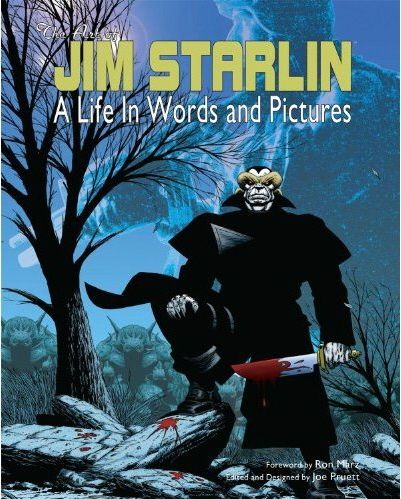"Dreadstar" #2 is cover dated January 1983 and I was born at the end of that month. Jim Starlin made some of his most well known and well regarded comics before I was even born, but my dad read comics, so I grew up with them. I flipped through and studied his "Dreadstar" run so much that, when I recently sat down to read it all, it was like stepping into a half-forgotten memory, a mess of jumbled images out of order but nonetheless familiar. When it comes to comics, Starlin's name is one that will always be one of the first I think of and, now, IDW has published a fantastic book showcasing his 40-year career through his art and through commentary that he provides. All of the well-known high points are represented, but so too are the forgotten or rare projects and pieces of art. It's an art book that also serves as a brief autobiography and it's a must read for Starlin fans. Hell, it's a must read for comics fans.
The first three chapters of "The Art of Jim Starlin: A Life in Words and Pictures" details his early career and life from his pre-comics days in the navy through fanzine and early Marvel work into his acclaimed and legendary runs on "Captain Marvel" and "Warlock." Immediately, the art presented show the stylistic hallmarks of Jim Starlin and a style that he develops through his first ten years as a professional artist. This is the period during which he defined 'cosmic comics' and influenced everyone who would dabble in that subgenre. One look at his "Insanity Portfolio" from 1974 and you can see the blueprint for much of his career as he combined psychedelic imagery with the inner workings of the mind.
The early years also show a contrast between two differing Starlins: the cover artist and pseudo art director for Marvel, and the artist yearning to try new things and not be constrained by what others want. After "Warlock," Starlin entered into what he calls his "favorite period in the business," beginning "The Metamorphosis Odyssey" for "Epic Illustrated" and working in a painted style. Though "The Metamorphosis Odyssey" has been reprinted, it's only been shown in black and white since its original serialization in the first nine issues of "Epic Illustrated." This book offers the first chance for a lot of people to see Starlin's color painted art. The precursor to "Dreadstar" was a big leap forward for Starlin artistically and this chapter is probably the most gorgeous of the book.
After this period and the chapters on "The Death of Captain Marvel" and "Dreadstar," the book becomes less engaging and visually stunning, mostly because Starlin stopped drawing comics in favor of writing novels with his then-wife and doing other work outside of comics. Even when he returned in the late '80s, it was as a writer primarily, so the chapters on his "Batman" run and his Marvel work centered around "The Infinity Gauntlet" are briefer than some would like. This is primarily an art book and a few images from his artistic collaborators are included, but it's understandable why these chapters are brief and seem a little more text heavy. The "Infinity Gauntlet" period chapter does feature some interesting commentary on how Starlin views Ron Lim as an artist with very similar sensibilities and a similar approach.
Starlin's commentary throughout the book is interesting and provides insight into his work and some of his career decisions. A story of injuring his hand while inking "The Death of Captain Marvel" explains that book's unique visual style that's always stood out from the rest of Starlin's work as a small anomaly. His commentary on his recent runs with Marvel and DC paints a dim picture of work-for-hire, while Starlin also isn't afraid to be self-critical, openly calling some work subpar and not up to his standards.
Also included are four shorts that Starlin wrote and drew in the late '70s/early '80s that appeared in anthologies like "Epic Illustrated," "Heavy Metal," and "Eclipse Magazine." They show off a variety of his drawing styles from the time period and range from obtuse poetics to a funny rhyme about losing one's soul to the devil to a religious parable about holy wars. While a collection of his lesser known works is definitely something worth pursuing, these shorts make for a great 'bonus feature,' giving Starlin fans yet another reason why this book is a must have.
An oversized hardcover clocking in at just over 300 pages, "The Art of Jim Starlin: A Life in Words and Pictures" is a gorgeous book showcasing the art of one of the somewhat overlooked masters of the last 40 years. Starlin defined and shaped the concept of 'cosmic comics' through his experimental and bold visuals. Despite most of the focus lying on the first half of his career, the second half shows that Starlin is still an artist interested in pushing the limits. Open this book to any page and you'll see something amazing.

